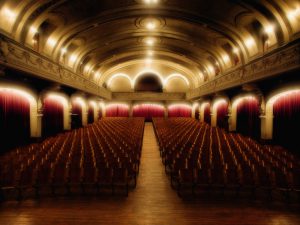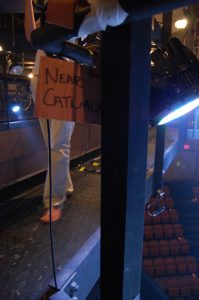Educating a Brighter Future, Part 1
Posted on April 11, 2013 My Journey in Lighting
My Journey in Lighting
written by guest blogger Frank Danko
Editor’s note: Mr. Danko was recently at Chauvet HQ for a training session. While here, he shared a quick, yet passionate speech about the benefits of USITT and theater education in general with the group. We were so taken with it that we asked him to write a post as a guest blogger. And here it is…in two parts. Enjoy!
I am not an educator in the formal sense of the word, so please forgive my grammar. However, what I do is certainly educational for those I am fortunate enough to meet in my travels. As the theatrical lighting representative at BMG Hudson Sales & Marketing (NY/NJ), I have the great pleasure to educate customers and colleagues alike on the quality products manufactured by CHAUVET Professional. My lessons certainly do not  take place in a classroom, my lessons come alive in offices, theatres, venues and the occasional bar. As lighting professionals, we must be in constant pursuit of knowledge to grow with our industry and further the development of those around us.
take place in a classroom, my lessons come alive in offices, theatres, venues and the occasional bar. As lighting professionals, we must be in constant pursuit of knowledge to grow with our industry and further the development of those around us.
Never stop learning.
Many of us have not been in the classroom setting in quite some time, but we remain eager to learn in our professional lives. Through educational organizations, such as the United States Institute for Theatre Technology (USITT), there are wonderful programs for aspiring technicians and seasoned veterans alike. Since 1960, USITT has been dedicated to the growth of our industry and the education of our future technicians. Its commitment to our future has developed new technology allowing our industry to adapt in this ever-changing world. I sincerely hope you were able to attend the recent USITT held in Milwaukee, Wis. I was not able to attend, but it did remind me of my personal journey in lighting; one that I’m proud to share with you in this blog post.
But what do you do?
A few years ago, while hosting a workshop on lighting design for high school students, I was asked, “what does a theatrical technician do?” I have spent the majority of my career working as a technician, but I never asked myself the WHAT question. I thought it was obvious to anyone who has ever seen a show, and so my answer was “We do everything!” The student looked at me sideways and under her breath I could hear her say, “That didn’t answer the question.” In an effort to clarify, I began to list the responsibilities of technicians: we hang, focus and program lights, run cables, call shows, move sets, set microphones, push boxes, hand off props and even dress the talent. I could see she was beginning to understand and like a batten falling from overhead; it suddenly hit me that the WHAT didn’t matter. I never cared what the task was, I was just happy to be a part of something larger than me.
 The great white dream.
The great white dream.
As a young teenager, much like the students who attended my workshop, I was eager to learn. At the time, I never thought of pursuing a career in technical theatre, in fact, I was destined to be on Broadway. Growing up 20 minutes outside of NYC, I was fortunate to attend shows from a young age; naturally I wanted to be on stage. It wasn’t until my high school performing arts director asked me to come to “Stage Crew” that my perspective changed. I walked in the auditorium and there were all of these young people just like me, playing with power tools, painting sets, focusing lights and turning microphones on and off. This was a whole different world and I must admit, it was a bit overwhelming at first. It was quickly made very clear by the senior crew chief—this wasn’t rehearsal, this was work. So I began to work, first by helping push the Genie lift around for one of the upper classmen focusing front of house. I asked questions, I listened and followed directions to the best of my ability. At the end of the day my teacher approached me and asked, “Coming back next week?” To which I replied, “Absolutely!”
Soaking up knowledge.
In my junior year, our school bought a new computerized lighting console. It didn’t operate on AMX like our original board, it was a technology called DMX 512-A, one that I was not familiar with. Like any good techie, I started to research this new console and the DMX protocol and discovered USITT. It is responsible for DMX512-A becoming the industry standard in entertainment lighting. While researching USITT, my teacher also informed me of several great organizations like the NYS Theatre Education Association (NYSTEA), Educational Theatre Association (EdTA) and the International Thespian Society. These organizations were working to make theatre education a priority. This seemed important to me, very important. I became involved with NYSTEA because of my teachers involvement and I attended my first event, right in my own school. There were over 100 students from my region who had the same interests as me and I spent the day taking workshops and soaking up knowledge.
Sharing newfound knowledge.
My teacher informed me that USITT would be hosting a conference in Pittsburgh, Pa., later in the year. I asked my parents if I could attend, they were reluctant but took a friend from stage crew and myself to the event. I saw all the exhibits, played with equipment and even programmed my first intelligent fixture. I walked the show floor for hours, met industry professionals and listened intently to everyone I encountered. It was an amazing experience and I couldn’t wait to tell my teacher and classmates about it.
The journey continues. Click here to read part two.
Inspired to learn more? Please feel free to contact me at [email protected].